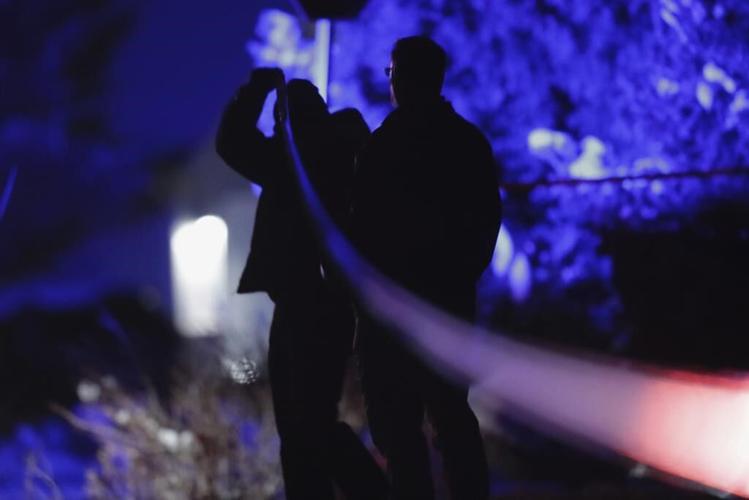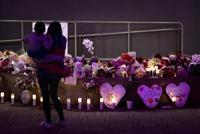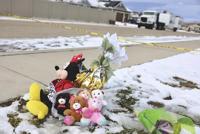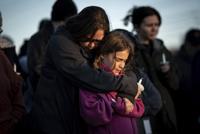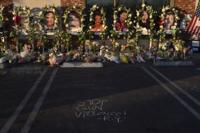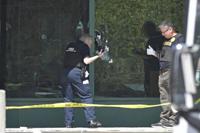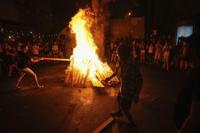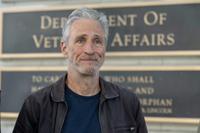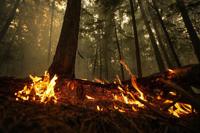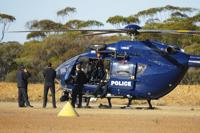LOS ANGELES (AP) — Four people found shot to death in an RV in a small Mojave Desert community in California. Four partygoers slain and 32 injured in small-town Alabama during a Sweet 16 birthday that ended with a girl kneeling beside her fatally wounded brother. Six people, included three 9-year-old children, gunned down at an elementary school in Nashville.
Now the discovery of seven people found shot to death in rural Oklahoma is keeping the U.S. on a torrid pace for mass killings in 2023 and could push the number of people slain past 100 for the year.
The Mojave slayings over the weekend represented the 19th mass killing of the year, according to maintained by The Associated Press and USA Today in a partnership with Northeastern University. That is the most during the first four months of the year since data was first recorded in 2006. The Oklahoma deaths have not been added to the database as of Tuesday afternoon.
As of the Mojave shooting, 97 people had been killed in the 19 mass killings this year, exceeding the record set in 2009 when 93 people were killed in 17 incidents by the end of April.
The number killed is a fraction of the total number of people who died by homicide for the year. The database counts killings involving four or more fatalities, not including the perpetrator, the same standard as the FBI, and tracks a number of variables for each.
“Nobody should be shocked,” said Fred Guttenberg, whose 14-year-old daughter, Jaime, at a Parkland, Florida, high school in 2018. “I visit my daughter in a cemetery. Outrage doesn’t begin to describe how I feel.”
The Parkland victims are among the 2,851 people who have died in mass killings in the U.S. since 2006, according to the database.
Mass killings are happening with staggering frequency this year: an average of about one a week, according to an analysis of The AP/USA Today data.
The 2023 numbers stand out even more when they are compared with the tally for full-year totals since data was collected. The U.S. recorded 30 or fewer mass killings in more than half of the years in the database, so to be at 19 a third of the way through is remarkable.
The violence has erupted from coast to coast and has sparked by a range of motives. Murder-suicides and domestic violence; gang retaliation; school shootings; and workplace vendettas. All have taken the lives of four or more people at once since Jan. 1.
Yet barriers to change remain. The likelihood of Congress reinstating appears far off, and the U.S. Supreme Court last year for reviewing the nation’s gun laws, calling into question .
The pace of mass shootings so far this year doesn't necessarily foretell a new annual record. In 2009, the bloodshed slowed and the year finished with a final count of 32 mass killings and 172 fatalities. Those figures just barely exceed the averages of 31.1 mass killings and 162 victims a year, according to an analysis of data dating back to 2006.
Gruesome records have been set within the last decade. The data shows a high of and 230 people slain in such tragedies in 2017. That year, 60 people died when a gunman over an outdoor country music festival on the Las Vegas Strip. The massacre still from a mass shooting in modern America.
“Here’s the reality: If somebody is determined to commit mass violence, they’re going to,” said Jaclyn Schildkraut, executive director of the Rockefeller Institute of Government’s Regional Gun Violence Research Consortium. “And it’s our role as society to try and put up obstacles and barriers to make that more difficult.”
But there is little indication at either the state or federal level — with a handful of exceptions — that many major policy changes are on the horizon.
Some states have tried to impose more gun control within their own borders. Last month, Michigan Gov. Gretchen Whitmer mandating criminal background checks to purchase rifles and shotguns, whereas the state previously required them only for people buying pistols. And last week, Washington Gov. Jay Inslee into law. But it faces a federal court challenge.
Other states are experiencing a new round of pressure. In conservative Tennessee, to demand more gun regulation after the March shooting at the Nashville school.
At the federal level, President Joe Biden last year , toughening background checks for the youngest gun buyers, keeping firearms from more domestic violence offenders and helping states use red flag laws that enable police to ask courts to take guns from people who show signs they could turn violent.
Despite the blaring headlines, mass killings are , perpetrated by just a handful of people each year in a country of nearly 335 million. And there's no way to predict whether this year's events will continue at this rate.
Sometimes mass killings happen back-to-back — like in January, when in California occurred just two days apart — while other months pass without bloodshed.
“We shouldn't necessarily expect that this — one mass killing every less than seven days — will continue,” said Northeastern University criminologist James Alan Fox, who oversees the database. “Hopefully it won't.”
Still, experts and advocates decry the in recent years, including .
“We have to know that this isn’t the way to live,” said John Feinblatt, president of Everytown for Gun Safety. “We don’t have to live this way. And we cannot live in a country with an agenda of guns everywhere, every place and every time.”
Jaime Guttenberg would be . Her father now spends his days
“America shouldn’t be surprised by where we are today,” Guttenberg said. “It’s all in the numbers. The numbers don’t lie. But we need to do something immediately to fix it.”
___
Fenn reported from New York.
___
This story has been corrected to say that shootings are happening an average of about once a week, not nearly one a week.

